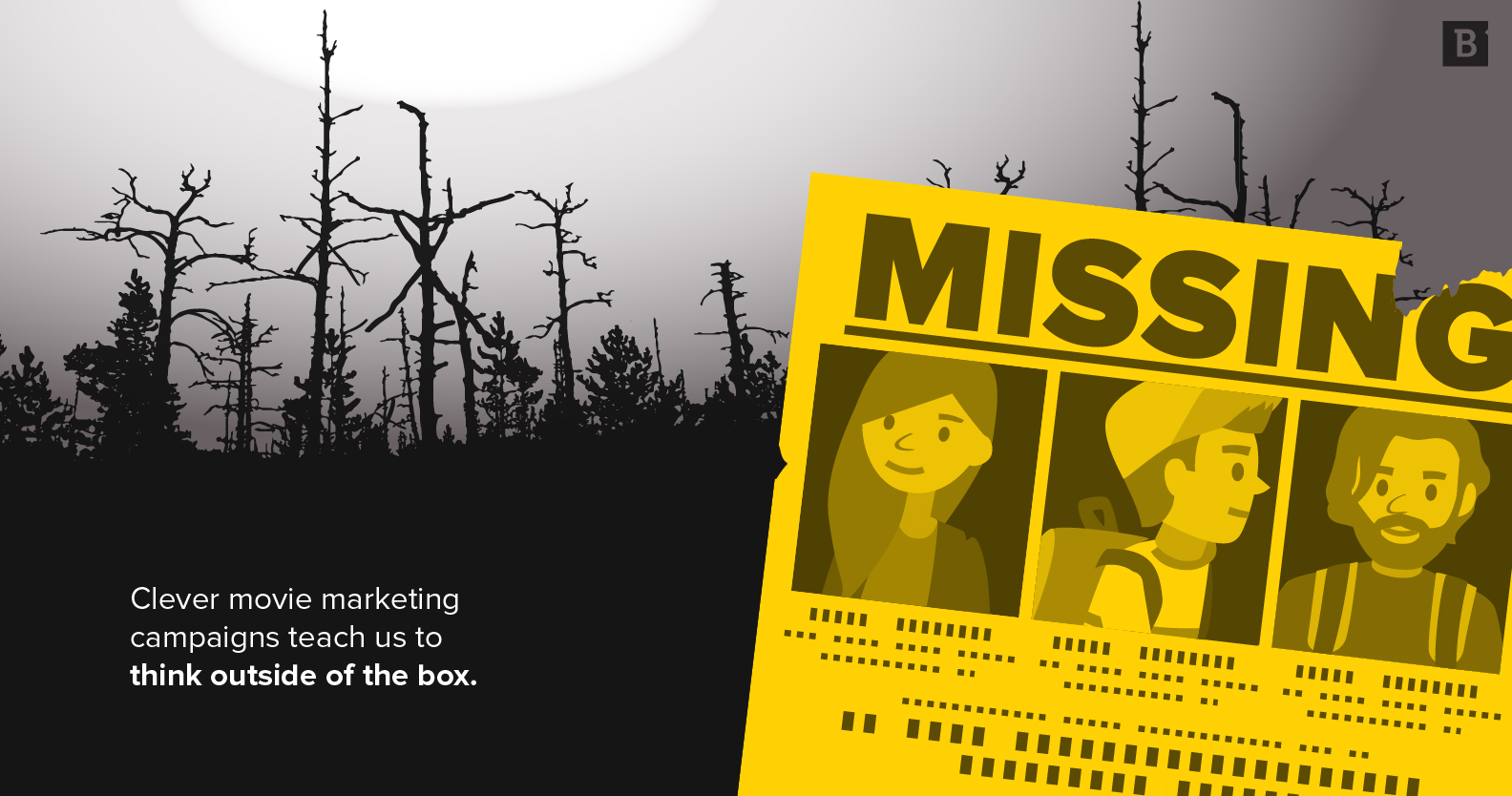Product quality trumps everything. It sounds nice, but that’s not always the case with consumer audiences. And it’s especially not when it comes to the film industry. How else can you explain the continuing popularity of the “Transformers” franchise? Or the fact that they made 8 (yes, 8) “Police Academy” movies?
In reality, movie marketing matters just as much as the actual film itself. A bad movie with good buzz can still make bank, but a great film can go unappreciated for decades. We don’t mean to single out the film industry as being especially egregious when it comes to shrewd marketing practices that spin gold out of nothing.
But, there’s no denying that Hollywood history is rich with bold marketing stunts and grassroots campaigns that, for better or worse, put butts into seats.

Movie Marketing Campaigns That Hit the Mark
Take a look at the most clever and memorable movie marketing campaigns ever devised. Who knows? You might just learn something from these silver screen mavericks:
Subscribe to
The Content Marketer
Get weekly insights, advice and opinions about all things digital marketing.
Thank you for subscribing to The Content Marketer!
1. ‘Blair Witch’ Fools Us All
The found-footage sub-genre is pretty played out at this point, but there was a time when it was a legitimately revolutionary approach to film-making — really coming into its own with 1999’s “Blair Witch Project.”
The film follows 3 “real” filmmakers as they trek through the Maryland woods in search of the titular witch. Things quickly go south, as they tend to do in horror films, and the protagonists are besieged by a seemingly supernatural force.
Plot-wise, it’s a pretty by-the-numbers story, but where “Blair Witch” stood out was with its marketing campaign.
With a budget of just $60,000 and 3 unknown actors in the leading roles, “Blair Witch Project” looked like the real deal: a genuine piece of found footage that chronicled a potentially paranormal event. Producers doubled down on that veneer of authenticity, going so far as releasing fake missing person posters for the cast members and asking film festival attendees for information on their whereabouts.
What really established “Blair Witch Project” as a milestone in movie marketing was its use of the then-still-nascent internet.
Marketers posted fake newsreels and police reports on the film’s website, further driving the message that the movie was an authentic piece of found footage. Today, that kind of tactic is pretty standard stuff, but back in the early days of the internet, it was revolutionary. Even today, the movie’s marketing overshadows the content of the film itself, which hasn’t aged quite as well.
2. ‘Deadpool’ Takes Over
For 2016’s largely anticipated movie “Deadpool”, Marvel’s movie marketers went all out with their viral marketing approach. There was so much marketing material, it perfectly mimicked the protagonist’s cocky and invasive humor. From custom emojis on social media to countless parody posters, Deadpool was everywhere to be seen.
Other film promotion highlights include a feud with Wolverine, a fake costume reveal and a Christmas-themed flaming bag of — well — poop. They even capitalized on circulating concerns about the film with an April Fool’s Day prank. There were worries that the film was going to be PG-13, not R-rated as expected. In an interview with Ryan Reynolds, he announced that the film was going to be PG to stir up the fans further — only for Deadpool to arrive in the background and hit the interviewer around the head with a spotlight.
The content was filling movie-goers up with the promise that the movie was going to be as silly and naughty as it needed to be — if not more. After reaching the target audience and spreading the right messages, Deadpool, of course, became an absolute hit.
3. ‘Cloverfield’ Creates a Digital Mystery
“Blair Witch Project” may have set an early template for movie marketing in the digital age, but “Cloverfield” arguably perfected it. During the run-up to the film’s 2008 release, the film’s marketing campaign teased moviegoers with cryptic information regarding the movie without ever betraying any details about the plot itself.
Early trailers confused and intrigued movie theater audiences in equal measure, as they focused on intimate, handheld recordings of a group of New York yuppies before cutting to disconnected glimpses of carnage across the city. It wasn’t much to go off (the trailers didn’t even include the film’s title, kicking off even more speculation), but there was enough to whet the appetite of film fans everywhere.
Producer J.J. Abrams and his marketing team went on a tear, trickling out hints about the film’s plot online. And, just like that, Abrams created one of Hollywood’s first viral sensations, encouraging internet users to join in and crack the case. Speculation surrounding the film continued to ramp up, and it was eventually released six months after the initial teaser trailer to major acclaim and box office success.
4. ‘Star Wars’ Carves Its Own Path
“Star Wars” has been a cultural force for more than 40 years, and somehow, it’s never been more popular. It’s easy to forget that this science fiction juggernaut was not even close to pop-culture when it was released in 1977. Cast and crew speculated about its box office prospects, with many believing they had a massive bomb on their hands.
Say what you want about George Lucas, but back in the ‘70s, the man was a movie marketing visionary. Before “Star Wars” was released, Lucas bucked typical publicity practices at the time by actively courting merchandising opportunities and getting a line of toys ready to spread brand awareness before anyone knew if the film would even make its budget back.
Star Wars turned out to be a cultural phenomenon that touched viewers of all ages worldwide. And Disney knew how to capitalize on this. They created a new trilogy and delved into the lore with movies like “Han Solo” and “Rogue One”, as well as various other Star Wars specials. As the champion of nostalgia, Disney is well-versed in stealing the hearts of their audience. Their movie marketing campaigns incorporated a lot of drip-feed marketing to build excitement and anticipation around the new films.
Before the first film of the latest Star Wars trilogy “The Force Awakens” went to the cinema, Disney released a series of posters, documentaries and behind-the-scenes footage to tease fans. This method worked brilliantly as countless cinemas across the globe sold out their screens for the midnight viewing. To generate interest in new products, consider ways to drop hints that something big is on the way instead of making a simple announcement.
5. ‘Paranormal Activity’ Uses Its Audience as Bait
Horror movies appear to go hand-in-hand with innovative marketing. Especially with “Paranormal Activity”’s contribution.
By 2007, found footage had been done to death. No one was going to mistake a story about a couple recording their haunted house with baby cams and security devices for the real McCoy, so film marketers had to go a different route to sell tickets.
Let’s just say the movie’s test screenings went well – really well.
“Paranormal Activity” producers capitalized on audience reactions during the movie’s test screenings for its marketing campaign – rather than focusing on the movie itself. Commercials showcased footage with night-vision cameras that captured frightened moviegoers screaming, gasping and recoiling in shock.
It worked like a charm; “Paranormal Activity” generated a lot of buzz on a small budget, and kicked off a long-running movie franchise.
6. Hitchcock Keeps Moviegoers in the Dark
Sometimes even geniuses fall backward into success. There’s no question that Alfred Hitchcock was a master of both suspense and movie marketing. But one of his greatest promotional moments came about entirely by accident.
1960’s “Psycho” was arguably one of the biggest bait-and-switch plots in film history. Hitchcock was fiercely protective of his movie’s plot twist. The film’s actors were barred from doing publicity interviews, and the trailers gave away minor details regarding the story.
Hitchcock wanted the audience to be completely in the dark about what his film had in store for them.
But how did he generate interest while offering such little information? The answer is Hitchcock’s secrecy.
He demanded that theaters prevent anyone from entering once the film started. Hitchcock’s policy had two major effects on moviegoers:
- It further piqued the interest of those who were intrigued by the director’s cagey behavior up to that point.
- It forced latecomers to wait for the next showtime, which created long lines that often extended outside the theater.
Although Hitchcock’s main goal was to protect the integrity of his film and the moviegoing experience, he inadvertently created a ton of buzz for the low-budget thriller.
7. ‘Black Panther’ Becomes a Cultural Force
In the grand scheme of the Marvel Cinematic Universe, “Black Panther” was not expected to be a heavy hitter. Despite this, “Black Panther” became an instant classic and a bona fide cultural phenomenon, raking in more than $1.3 billion worldwide.
The film’s producers and creators knew what a huge deal it was to depict the MCU’s first African-American superhero and actively marketed the film to those demographics. They made a point to bring on people of color at every stage of development, from the screenwriters to the director and, of course, the cast.
“Black Panther” TV spots featured prominently during programs that had high viewership numbers among African-Americans. For instance, the movie’s very first teaser was aired during the NBA Finals.
“Black Panther” embraced black culture in a way that arguably no other major Hollywood movie ever has, coinciding with the rise of movements like “Black Lives Matter”. By taking its established movie-making formula and targeting an audience segment that was clamoring for greater representation, Marvel had one of its greatest success stories to date.
Making an Impact Inspired by Movie Marketing
If there’s one takeaway here, it’s that it often pays to think outside the box. You don’t always have to follow what everyone is doing with their digital marketing campaigns. Actually, if you want to really stand out, you probably should be aiming to do something completely out of the ordinary. Don’t be afraid to experiment with a new marketing strategy and see if it sticks. It might just be worth the risk.
Editor’s Note: Updated May 2023.





